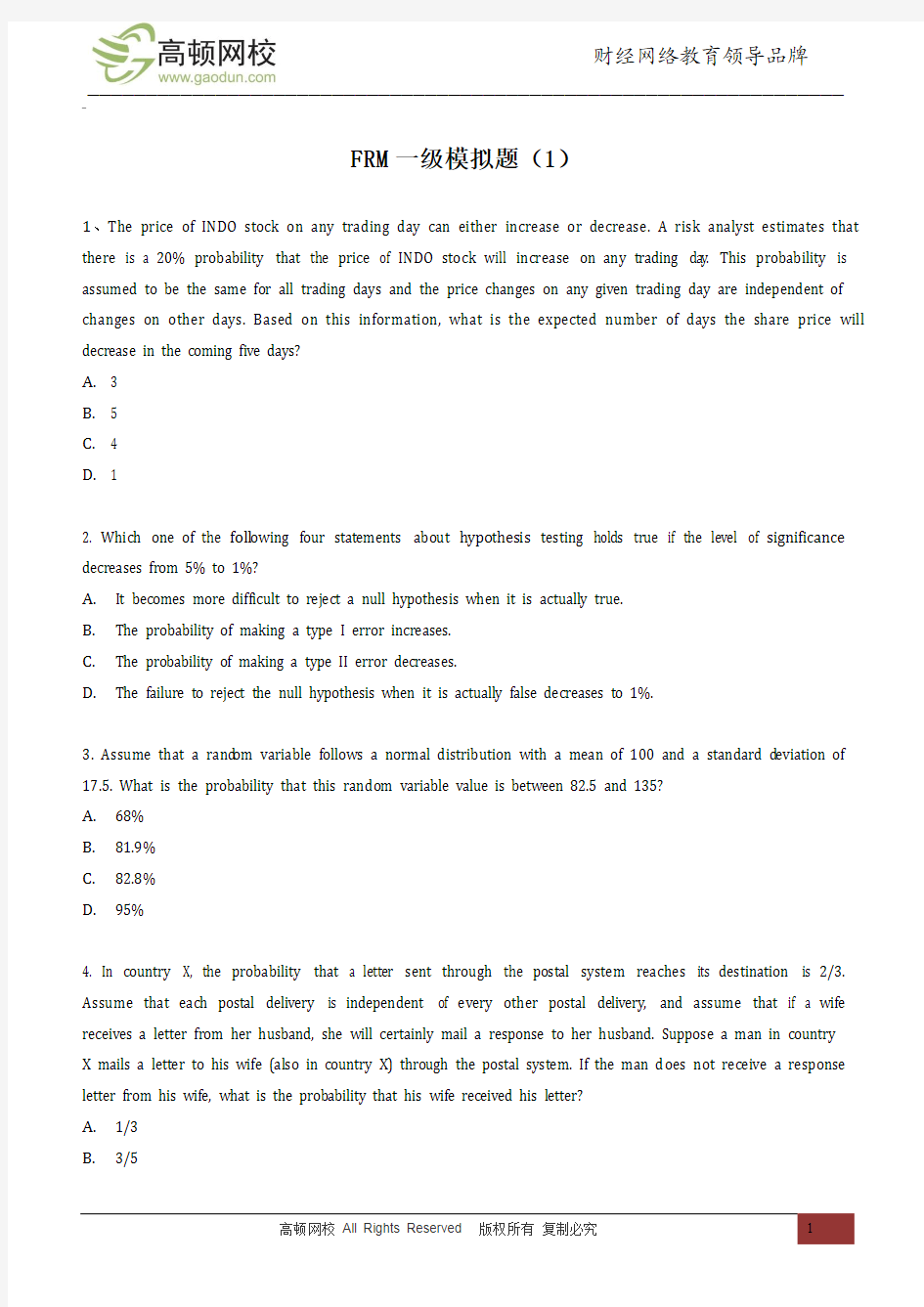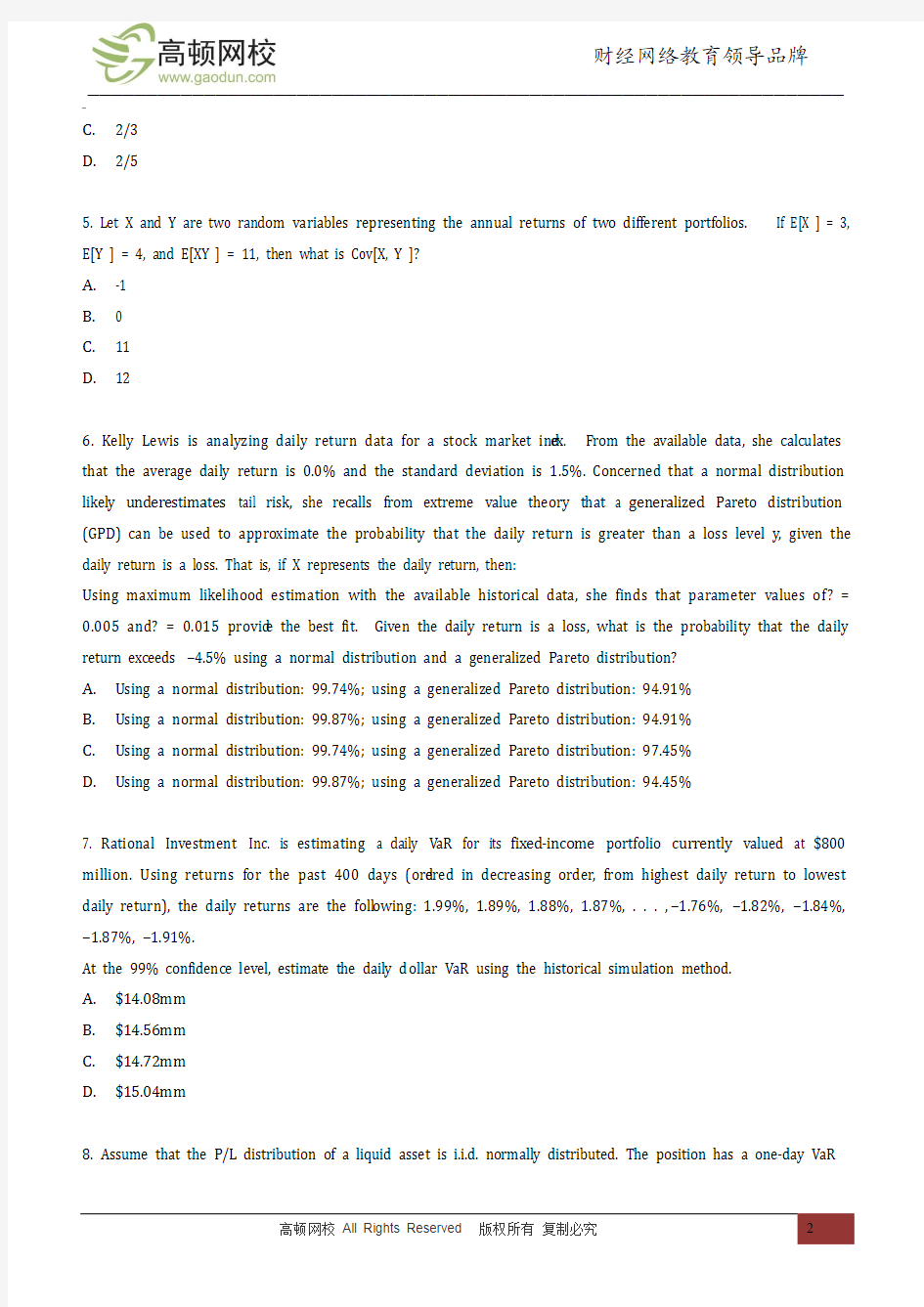FRM一级模拟题(1)


FRM一级模拟题(1)
1、The price of INDO stock on any trading day can either increase or decrease. A risk analyst estimates that there is a 20% probability that the price of INDO stock will increase on any trading day. This probability is assumed to be the same for all trading days and the price changes on any given trading day are independent of changes on other days. Based on this information, what is the expected number of days the share price will decrease in the coming five days?
A. 3
B. 5
C. 4
D. 1
2. Which one of the foll owing four statements about hypothesis testing holds true if the level of significance decreases from 5% to 1%?
A.It becomes more difficult to reject a null hypothesis when it is actually true.
B.The probability of making a type I error increases.
C.The probability of making a type II error decreases.
D.The failure to reject the null hypothesis when it is actually false decreases to 1%.
3. Assume that a rand om variable foll ows a normal distribution with a mean of 100 and a standard d eviation of
17.5. What is the probability that this rand om variable value is between 82.5 and 135?
A.68%
B.81.9%
C.82.8%
D.95%
4. In country X, the probability that a letter sent through the postal system reaches its destination is 2/3. Assume that each postal delivery is independent of every other postal delivery, and assume that if a wife receives a letter from her husband, she will certainly mail a response to her husband. Suppose a man in country X mails a letter to his wife (also in country X) through the postal system. If the man d oes not receive a response letter from his wife, what is the probability that his wife received his letter?
A.1/3
B.3/5
C.2/3
D.2/5
5. Let X and Y are two rand om variables representing the annual returns of two different portfolios. If E[X ] = 3, E[Y ] = 4, and E[XY ] = 11, then what is Cov[X, Y ]?
A.-1
B.0
C.11
D.12
6. Kelly Lewis is analyzing daily return data for a stock market ind ex. From the available data, she calculates that the average daily return is 0.0% and the standard deviation is 1.5%. Concerned that a normal distribution likely underestimates tail risk, she recalls from extreme value theory that a generalized Pareto distribution (GPD) can be used to approximate the probability that the daily return is greater than a loss level y, given the daily return is a loss. That is, if X represents the daily return, then:
Using maximum likelihood estimation with the available historical data, she finds that parameter values of? = 0.005 and? = 0.015 provid e the best fit. Given the daily return is a loss, what is the probability that the daily return exceeds –4.5% using a normal distribution and a generalized Pareto distribution?
https://www.360docs.net/doc/ef18961458.html,ing a normal distribution: 99.74%; using a generalized Pareto distribution: 94.91%
https://www.360docs.net/doc/ef18961458.html,ing a normal distribution: 99.87%; using a generalized Pareto distribution: 94.91%
https://www.360docs.net/doc/ef18961458.html,ing a normal distribution: 99.74%; using a generalized Pareto distribution: 97.45%
https://www.360docs.net/doc/ef18961458.html,ing a normal distribution: 99.87%; using a generalized Pareto distribution: 94.45%
7. Rational Investment Inc. is estimating a daily VaR for its fixed-income portfolio currently valued at $800 million. Using returns for the past 400 days (ord ered in decreasing order, from highest daily return to lowest daily return), the daily returns are the foll owing: 1.99%, 1.89%, 1.88%, 1.87%, . . . , –1.76%, –1.82%, –1.84%, –1.87%, –1.91%.
At the 99% confidence l evel, estimate the daily d ollar VaR using the historical simulation method.
A.$14.08mm
B.$14.56mm
C.$14.72mm
D.$15.04mm
8. Assume that the P/L distribution of a liquid asset is i.i.d. normally distributed. The position has a one-day VaR
at the 95% confidence level of $100,000. Estimate the 10-day VaR of the same position at the 99% confid ence level.
A.$1,000,000
B.$450,000
C.$320,000
D.$220,000
9. On March 13, 2008, William Tell, a fund manager for the Rossini fund, takes a short position in the March Treasury bond (T-bond) futures contract. He plans to deliver the cheapest-to-d eliver Treasury bond with a coupon of 41/2 percent payable semiannually on May 15 and November 15, a conversion factor of 1.3256, and a face value of USD 100,000. The delivery date is Friday, March 15. The settl ement price for the cheapest-to-deliver Treasury bond on March 13 is 682/32. Calculate the invoice price.
A.$90,118.87
B.$91,727.79
C.$92,367.75
D.$95,619.47
10. A newly issued noncallable fixed-rate bond with 30-year maturity carries a coupon rate of 5.5% and trades at par. Its duration is 13.84 years and its convexity is 529.714. Which of the foll owing statements about this bond is true?
A.If the bond were to start trading at a premium, its duration woul d decrease.
B.If the bond were to start trading at a discount, its duration would not change.
C.If the bond were to remain at par, its duration woul d increase as the bond aged.
D.If the bond were to remain at par, its duration woul d increase as the bond aged.
Answer and Explanation:
1、Prob (price up) = 0.20, meaning that Prob (price d own) = 0.80. It is the same for all days. Price change in a given day is independ ent of the price change on other days. So, the number of days where the stock price goes d own within 5 trading days has a binomial distribution with parameter n = 5 and q = 1 –0.20 = 0.80. Its expected value is 5(0.80) = 4.
2、Type I error: The rejection of the null hypothesis when it is actually true. Type II error: The failure to reject the null hypothesis when it is actually false.
The significance level is the probability of making a type I error.
3、(A) is incorrect. Almost 68% of the observations will be within the interval from one standard deviation below the mean to one standard d eviation above the mean, which is within the interval [100 –17.5; 100 +
17.5].
(B) is correct. 82.5 =100–17.5 and 135 = 100 + 2*17.5. So, the percentage is 34% on the left-hand side of the mean, plus 95%/2 on the right-hand side of the mean.
(C) is incorrect. Almost 95% of the items will lie within the interval from two standard deviations bel ow the mean to two standard deviations above the mean, that is, within the interval [100 – 2 * 17.5; 100 + 2 * 17.5]. (D) is incorrect. This answer assumes wrongly that 97.5% of the observations will be within [100 – 2 * 17.5; 100 + 2 * 17.5].
4、A = Event that the wife receives the man's letter
B = Event that the man d oes not receive a response from his wife
We need to find P(A|B).
First, we know P(A) = 2/3.
To get P(B), note that there are three possible scenarios.
(1). His letter d oes not get to his wife—probability is 1/3.
(2). Her response letter does not get to him—2/9 (= 2/3 * 1/3, probability that she gets his letter times the probability that her letter gets lost).
(3). Her response letter d oes get to him—4/9 (= 2/3 * 2/3, probability that she gets his letter times the probability that her letter gets to him).
He does not receive a response in scenarios 1 and 2, so P(B) = 5/9.
Next, we also know P(B|A) = 1/3 (if she receives the l etter, she responds, so he d oes not get a response only if the letter is l ost, which happens with probability 1/3).
Then, by Bayes' rule, P(A|B) = P(B|A) * P(A) / P(B) = (1/3) * (2/3) / (5/9) = 2/5.
5、We can rewrite Cov[X, Y ] as E[XY ] – E[X ]E[Y ]. Then, Cov[X, Y ] = 11 – 3 * 4 = –1.
(A) is correct because the formula was used correctly, E[XY ] – E[X ]E[Y ].
(B) is incorrect because it assumes zero covariance, which is false when the formula is used.
(C) is incorrect because the product of the two expectations of X and Y was not subtracted from the joint expectation E[XY ].
(D) is incorrect because the covariance is not the product of the two expectations of X and Y.
6、The GPD value is derived simply by plugging in y = –0.045 in the equation. The normal distribution value is derived by:
Prob(X > –0.045 | X < 0) = 1 – Prob(X < –0.045|X < 0)
= 1 – (Prob(X < 0|X < –0.045) * Prob(X < –0.045)) / Prob(X < 0)
= 1 – (1.0 * Prob(X < –0.045)) / Prob(X < 0)
= 1 – Prob(Z < –3) / Prob(Z < 0)
= 1 – 0.0013/0.5
= 0.9974
7、VaR = 1.82% * 800 = 14.56 million Topic:
VaR, nonparametric calculation
8、The question tests the ability to convert VaRs. The one-day VaR should be multiplied by the square root of time and the ratio of the confidence intervals to get the correct VaR.
Alternative (A) simply multiplies the VaR by T.
Alternative (C) multiplies the VaR by the square root of T.
Alternative (D) multiplies by the square root of T but inverts the ratio (1.64/2.32) instead of (2.32/1.64).
9、The invoice is based on a settlement price of 682/32 or 68.0625. The accrued interest is cal culated on the basis of the number of days since the last coupon payment date, November 15, and the delivery date, March 15. That is 121. During the current six-month period between coupon payment dates, November 15 to May 15, there are 182 days. Thus the accrued interest on $100,000 face value of the bond is:
121/182 * $100,000 * 0.045/2 = $1,495.88
The invoice price is:
$100,000 * 0.680625 * 1.3256 + $1,495.88 = $91,719.53
10、(A) is correct. At higher interest rates, the bond/price relationship is cl oser to linear than it is when rates are l ow. So, the new duration woul d be lower than 13.84. Alternatively, one can think of duration as a weighted average of the times when cash fl ows are made, where the weights are the percentage of the total value of the bond. When rates rise, the present values associated with the later payments are relatively smaller and the duration falls.
(B) is incorrect because it is the exact opposite of (A), the correct answer.
(C) is incorrect. It fails to recognize the logic stated in (A).
(D) is incorrect because duration is a function of the bond's maturity and, all else constant, duration woul d decrease as the bond's maturity shortened.
参与FRM的考生可按照复习计划有效进行,另外高顿网校官网考试辅导高清课程已经开通,还可索取FRM 考试通关宝典,针对性地讲解、训练、答疑、模考,对学习过程进行全程跟踪、分析、指导,可以帮助考生全面提升备考效果。更多详情可登录高顿网校官网进行咨询。
更多FRM考试资讯,请关注官方微信公众号:gaodunfrm
